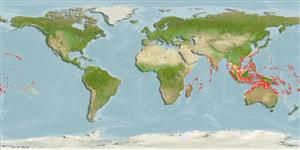>
Tetraodontiformes (Puffers and filefishes) >
Balistidae (Triggerfishes)
Etymology: Melichthys: Greek, melas, melaina, melan, black + icthys yos, fish. On the other hand, in Smith et al.,1986: 878), 'body dark brown to black' in https://www.biodiversitylibrary.org/item/266635#page/902/mode/1up.(P. Romero, pers.comm. 03/2022)..
More on author: Richardson.
Environment: milieu / climate zone / depth range / distribution range
Écologie
marin récifal; profondeur 0 - 60 m (Ref. 1602). Tropical; 32°N - 31°S, 30°E - 132°W
Indo-Pacific: East Africa eastward through northern Australia to Hawaiian and Tuamotu islands, north to southern Japan.
Taille / Poids / Âge
Maturity: Lm ? range ? - ? cm
Max length : 40.0 cm TL mâle / non sexé; (Ref. 30573)
Épines dorsales (Total): 3; Rayons mous dorsaux (Total): 31-35; Épines anales 0; Rayons mous anaux: 28 - 31. Juveniles with dark lines radiating from eye and dark lines on anal and soft dorsal fins (Ref. 4420).
Occur in seaward reefs to depths greater than 60 m (Ref. 9710, 48637), with rich invertebrate growth (Ref. 48637). Common in coral-rich areas exposed to currents (Ref. 1602). Usually at moderate depths in small loose groups (Ref. 48637). Benthopelagic (Ref. 58302). Diet consists mainly of algae and detritus but also takes in crustaceans, octopuses, sponges, and fishes (Ref. 1602). Oviparous (Ref. 205). Also taken with drive-in nets. Marketed fresh (Ref. 9770). Minimum depth reported taken from Ref. 128797.
Life cycle and mating behavior
Maturité | Reproduction | Frai | Œufs | Fécondité | Larves
Oviparous, distinct pairing during breeding (Ref. 205).
Matsuura, K., 2001. Balistidae. Triggerfishes. p. 3911-3928. In K.E. Carpenter and V. Niem (eds.) FAO species identification guide for fishery purposes. The living marine resources of the Western Central Pacific. Vol. 6. Bony fishes part 4 (Labridae to Latimeriidae), estuarine crocodiles. FAO, Rome. (Ref. 9770)
Statut dans la liste rouge de l'IUCN (Ref. 130435)
Menace pour l'homme
Harmless
Utilisations par l'homme
Pêcheries: intérêt commercial mineur; Aquarium: Commercial
Plus d'informations
RéférencesAquacultureProfil d'aquacultureSouchesGénétiqueElectrophoresesHéritabilitéPathologiesTraitementNutrientsMass conversion
Outils
Articles particuliers
Télécharger en XML
Sources Internet
Estimates based on models
Preferred temperature (Ref.
123201): 24.6 - 28.9, mean 27.6 °C (based on 692 cells).
Phylogenetic diversity index (Ref.
82804): PD
50 = 0.6250 [Uniqueness, from 0.5 = low to 2.0 = high].
Bayesian length-weight: a=0.02692 (0.01580 - 0.04584), b=3.05 (2.90 - 3.20), in cm total length, based on LWR estimates for this species & (Sub)family-body (Ref.
93245).
Niveau trophique (Ref.
69278): 3.4 ±0.39 se; based on food items.
Résilience (Ref.
120179): Milieu, temps minimum de doublement de population : 1,4 à 4,4 années (Preliminary K or Fecundity.).
Fishing Vulnerability (Ref.
59153): Low to moderate vulnerability (30 of 100).
Nutrients (Ref.
124155): Calcium = 37.2 [15.6, 91.1] mg/100g; Iron = 0.564 [0.291, 1.260] mg/100g; Protein = 18.4 [16.3, 20.6] %; Omega3 = 0.114 [0.057, 0.220] g/100g; Selenium = 37.6 [19.9, 77.0] μg/100g; VitaminA = 49.9 [14.5, 176.1] μg/100g; Zinc = 0.987 [0.674, 1.461] mg/100g (wet weight);
